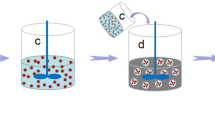Abstract
In order to improve the healing performance and increase the service life of the polymer matrix composites, microcapsules were prepared by interfacial polymerization process with urea formaldehyde resin and epoxy resin E-51 as the wall material and core material separately. The effects of core/shell mass ratio and emulsifier on the distribution, topography and encapsulation rate of microcapsules were investigated. By optimizing the conditions, microcapsules with little particle size, well dispersion and compact surface were prepared. The distribution, topography, stability and compositions of the microcapsules were characterized using Nano-2s, optical microscope, scanning electron microscopy, thermal analysis and Fourier transform infrared spectroscopy. The osmosis performance of the microcapsules was evaluated. The experimental results showed that the ratio of core/shell materials (1:1) and 1% DBS as emulsifier were optimum preparation conditions and the encapsulation rate was 62.5%. The microcapsules can be synthesized successfully with mean diameter 548.6 nm and exhibit a good chemical stability below 225 °C. The FTIR result indicated that urea-formaldehyde resin was formed and the core materials were successfully encapsulated in urea-formaldehyde shell. Osmosis performance evaluation showed that the microcapsules were well coated and slowly osmosed.
Similar content being viewed by others
References
Dry CM. Procedures Developed for Self-repare of Polymer Matrix Composite Materials[J]. Composite Structure, 1996, 35: 263–269
White SR, Sottos NR, Geubelle PH. Autonomic Healing of Polymer Composites[J]. Nature, 2001, 409: 794–797
Michael WK, White SR, Sottos NR. A Self-Healing Poly (Dimeethyl Siloxane) Elastomer[J]. Advanced Functional Materials, 2007, 17: 2399–2404
Gerald OW, Jeffrey SM, White SR. Autonomic Healing of Epoxy Vinyl Esters via Ring Opening Metathesis Polymerization[J]. Advanced Functional Materials, 2008, 18: 44–52
Blaiszik BJ, Sottos NR, White SR. Nanocapsules for Self-healing Materials[J]. Composite Science and Technology, 2008, 68: 978–986
Blaiszik BJ, Caruso MM, White SR. Microcapsules Filled with Reactive Solutions for Self-healing Materials[J]. Polymer, 2009, 50: 990–997
Yang J, Keller MW, Moore JS. Microencapsulation of Isocyanates for Self-Healing Polymers[J]. Macromolecules, 2008, 41: 9650–9655
Rule JD, Sottos NR, White SR. Effect of Microcapsule Size on the Performance of Self-healing Polymers[J]. Polymer, 2007, 48: 3520–3529
Wu DY, Meure S, Solomon D. Self-healing Polymeric Materials: A Review of Recent Developments[J]. Progress in Polymer Science, 2008, 33: 479–522
Li H, Wang R, Hu H. Surface Modification of Self-healing Poly (ureaformaldehyde) Microcapsules Using Silane-coupling Agent[J]. Applied Surface Science, 2008, 255: 1894–1900
Benthem RATM, Ming W, With G. Self Healing Polymer Coatings[J]. Self Healing Materials. An Alternative Approach to 20 Centuries of Materials Science, 2008, Springer: 139–159
Mason TJ, Phillip J. Applied Sonochemistry [M]. Weinheim: Wiley-VCH, 2002: 158–168
Ni Z, Du XX, Xing F. Effect of the Surfactant of Self-healing Epoxy Resin Microcapsule[J]. Journal of Shenzhen University in Statute of Chnology, 2008, 25(4): 351–356
Author information
Authors and Affiliations
Corresponding author
Additional information
Founded by the National Natural Science Foundation of China (21106022), the Science and Technology Planning Project of Guangdong Province, China (2013B010404045) and the Educational Commission of Guangdong Province, China (Yq2013100)
Rights and permissions
About this article
Cite this article
Cai, X., Fu, D. & Qu, A. Effects of processing conditions on the properties of epoxy resin microcapsule. J. Wuhan Univ. Technol.-Mat. Sci. Edit. 30, 689–694 (2015). https://doi.org/10.1007/s11595-015-1213-7
Received:
Accepted:
Published:
Issue Date:
DOI: https://doi.org/10.1007/s11595-015-1213-7




